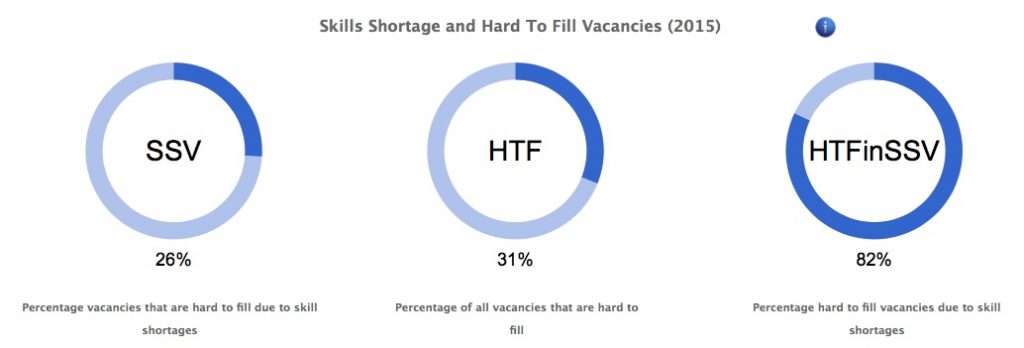Vacancies (incidence and causes)
Overview
Data source: Employer Skills Survey, Department for Education
Provision: Number of vacancies, Hard-to-fill vacancies, Skills shortage vacancies for 2011, 2013, 2015 and 2017
Update: approx. 2-3 years
Questions you can ask of the data:
- How many vacancies are reported in a particular occupation?
- What percentage of all vacancies are hard-to-fill?
Example of visualised data:

Source: RCU Ltd.
Description of the dataset and provenance
The Department for Education Employer Skills Survey (ESS) collects detailed information on skill deficiencies including skill shortage vacancies with occupations classified using SOC2010. They survey has been conducted in similar form every 2-3 years for over a decade. The survey is intended to produce robust estimates of the total number of vacancies, hard-to-fill vacancies and skill shortage vacancies in the UK from a sample of establishments.
Details of the owner / curator
A special interrogation of the data set to extract 4 digit SOC information has been carried out The most detailed geographical breakdown available is to regions in England and the other nations of the UK: Wales, Scotland and Northern Ireland. Time period: 2011, 2013, 2015 and 2017. The Department for Education Employer Skills Survey is conducted every two years. The 2011 ESS was the first survey to cover the entire UK.
Known quality issues with data
The survey does not collect data on the numbers employed in each occupation. Therefore, the indicators that are possible to generate are limited to the number of vacancies, hard-to-fill and skill shortage vacancies and the percentage of total vacancies which are hard-to-fill
and skill shortage.
It also provides information on only a subset of all vacancies.
The overall sample size is relatively large but when it comes down to focusing on detailed occupations the samples are quite limiting.
Quality control processes
The API suppresses sample cells with zero or small sample sizes.
Accuracy of data
Precise confidence intervals are not provided around the point estimates. The following “rules of thumb” have been adopted:
- If the number of establishments involved in generating and estimate is below 50 then a query about the related Skill Shortage Vacancies will return “no reliable data available” and offer to go up a level of aggregation across one or more of the main dimensions (e.g. UK rather than region, some aggregation of industries rather than the 75 level, or SOC 2 digit rather than 4 digit).
- Rounding of estimates – in order to avoid false impressions of precision the API rounds up the estimates before delivering the answer to any query. In the case of the Skill Shortage Vacancies estimates they are rounded to the nearest whole vacancy
Frequency of update
Does the data underlying the API change over time?
ESS is conducted once every 2-3 years. The data could in principle be updated at this frequency annually (but this would require the processing of the data described above under ‘Details of the owner / curator.
Will the data go out of date?
The data are as accurate as they can be at the time they are produced. As time goes by they become more out of date, but they can be updated when a new survey is carried out.
Does the data you capture change on at least a daily basis?
No – see above.
What type of dataset series is this?
Irregular time series information based on a series of cross-sectional surveys of employers (ESS).
Is a feed of changes made available?
No, see above.
How frequently do you create a new release?
Every 2-3 years, when ESS data are available.
What is the delay between creating a dataset and publishing it?
Once the data have been processed they can be uploaded to the LMI for All database.
Do you also provide dumps of the dataset?
No
Will the data be corrected if they contain errors?
Yes
Disclosure and confidentiality
The Department for Education complies with all applicable Data Protection laws in the UK.
The Skill Shortage Vacancies data included in this tool is non-disclosive
